| Published
on 23
Nov 2022 |
All rights reserved.
|
|
|
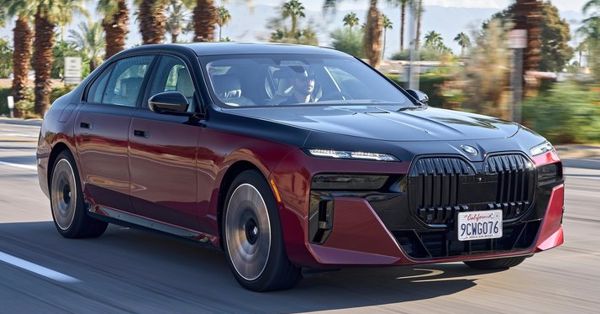
|
|
To
me, it is unquestionably the ugliest 7-Series ever made...
|
|
A few words can sum up the
7th generation BMW 7-Series: larger, uglier and electrified. To me, it
is unquestionably the ugliest 7-Series ever made. Boxy and bulky. The
nose is as vertical as a cliff. The bonnet is as flat as a dining
table. The flat roof and very high waistline abandon the sportiness
that characterized all the 7-Series preceding it. The tail looks as if
jacked up, very strange.
It looks as if BMW’s designers ran out of ideas, turning to its
Rolls-Royce sister division for inspiration, and therefore ended up
with a car just as bulky. This is even more evident when you order
2-tone paint scheme, which converts all the sheet metal above the
waistline level to black. Conservatism becomes its norm, which might
please its ever more important Chinese buyers – and by the way exposes
German motor industry’s over-reliance on the Chinese market – but works
against the tradition of the 7-Series, which should be avantgarde and
athletic.
Perhaps to balance that conservatism, its genius designers added an M
Performance option which turns the kidney grille into gloss black
together with the surrounding nose section. Unfortunately, it all looks
plasticky and incredibly cheap. Like an aftermarket effort, and a poor
one.
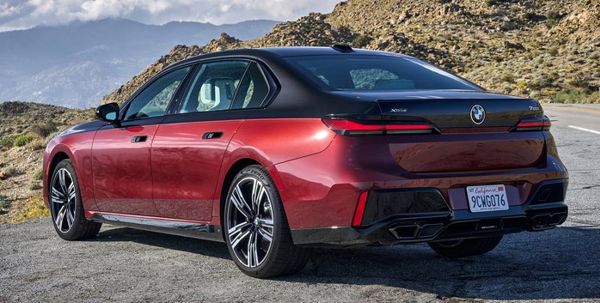
|
|
Rolls-Royce
proportion, 2-tone paint scheme and crystal headlights all point to a
flamboyance theme never seen before in the 7-Series.
|
|
Some might find its vertical front end and oversized double-kidney
grille as imposing as a Rolls-Royce, but where the latter has some
subtle curves at the side and at least some historical themes to speak
of, the large BMW is all about straight lines, bland surfacing – a
swing from Chris Bangle’s flame surfacing to bland surfacing – and some
awkward details which are hard to understand, in particular the
irregularly shaped rear quarter windows with uneven frames. BMW’s
Hofmeister kink has never been looking so strange. Sometimes I don’t
understand, BMW had already got a perfect Hofmeister kink in the form
of E34 and E39 5-Series or E38 7-Series, why does it abandon the
best and adopt something different just for the sake of different? Why
does it separate the LED main beams and daytime running lights? And why
does it add Swarovski crystals to the latter? The Rolls-Royce
proportion, the 2-tone paint scheme and the crystal headlights all
point to a flamboyance theme never seen before in the 7-Seriese, nor
any other BMW brand products. Maybe the parvenus in China will love
that, but this is also why I hate this car: the 7-Series trades
its soul for money.
The attempt to please Chinese buyers also drives up its size massively.
Short wheelbase is no longer available, as BMW concludes that Chinese
buyers want everything more. So all the 7-Series models now run 3215 mm
wheelbase, 5 mm longer than even the outgoing LWB car. Its overall
length is stretched even more, from 5.1 to 5.4 meters. Ditto the body
width which extends by
almost 50 mm. However, the most significant growth in my opinion is the
car's height, which is lifted by 66 mm to 1544 mm. Reason? It needs to
accommodate the floor-mounted battery for the i7 variant and plug-in
hybrid models.
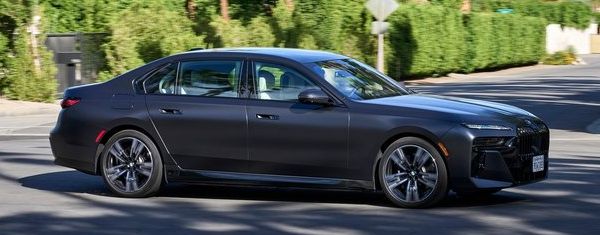 |
|
Fortunately,
driving dynamics remains true to BMW traditions.
|
|
Take the new 740i, which is expected to be best-selling globally, for
example. It tips the scale at 2090 kg DIN, 365 kg more than its direct
predecessor! And that's only a rear-drive and 6-cylinder model.
Granted, the new 740i compensates with more power. The latest version
of B58 3.0-liter petrol straight-six motor has its output lifted beyond
even the latest M340i for a total of 380 horsepower and 383 lbft of
torque. Besides, all straight-six engines (as well as V8) are now
assisted with an 48V integrated starter generator mild hybrid system
which offers up to 18 hp and 147 lbft at certain revs and
circumstances. This boosts the 740i's peak torque to 398 lbft. As a
result, the car is good for 0-60 mph in 5.2 seconds, identical to its
365 kg lighter predecessor. Top speed is limited to 155 mph, of course.
Although combustion engines are cruising to retirement, BMW still
updates its straight-six for improved efficiency. The latest version
gets Miller cycle operation capability by using Bi-Vanos to delay the
closure of intake valves. The exhaust valves get switchable rockers
such that they can be closed when throttle is released, reducing
frictional losses and letting the starter generator to recapture more
energy.
Offered exclusively in China as a budget choice is the entry-level
735i. It runs basically the same hardware as the 740i, but the engine
is detuned to 272 hp and 295 lbft. Combine with the mild hybrid system
the total is 286 hp and 313 lbft. 0-60 mph takes 6.4 seconds.
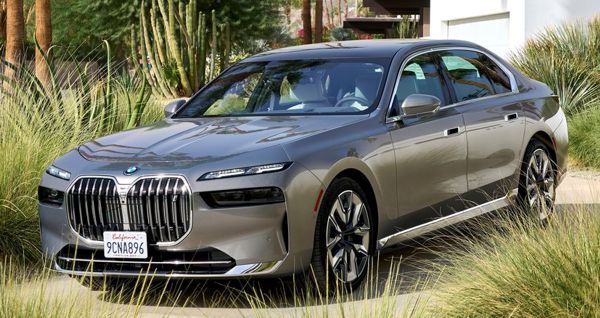 |
|
The
refined electric power of i7 suits the car very much.
|
|
Because of emission reasons, neither these mild-hybrid
petrol models are to be sold in Europe. Instead, European motorists
will have the choice of a diesel model (740d) and a pair of plug-in
hybrids (750e xDrive and M760e xDrive). The 740d engine is a slightly
updated version of the existing 3-liter straight-six. It produces 300
hp and 479 lbft (can be lifted to 494 lbft thanks to the mild-hybrid).
The 750e xDrive and M760e xDrive plug-in hybrid share much the same
hardware, i.e. 3-liter straight-six petrol, 18.7 kWh battery and a 200
hp / 206 lbft motor housed within the ZF 8-speeder. Only the tuning of
the petrol engines are different: the lesser car offers 310 hp and 332
lbft for a combined output of 490 hp and 516 lbft, good for 155 mph and
0-60 in 4.7 seconds, while the M760e engine produces 380 hp and 383
lbft (as in 740i) for a total output of 571 hp and 590 lbft, achieving
0-60 in only 4.1 seconds.
Strangely, despite the M-performance badge, M760e is not quite as quick
as the 760i xDrive, which is a conventional V8 car targeting mainly the
US market. That car's 4.4 V8 has been improved slightly again, lifting
horsepower to 544 and max. torque to 553 lbft. It takes 4.1 seconds to
go from
rest to 60 mph, even though the car weighs as much as 2270 kg.
Yet it is not the quickest version of the G70 generation. BMW said by
next year it will introduce the flagship, all-electric i7 M70 xDrive,
which will be good for 0-60 under 3.9 seconds. This car will
effectively replace the V12-powered M760i. Yes, BMW’s V12 has already
been consigned to history.
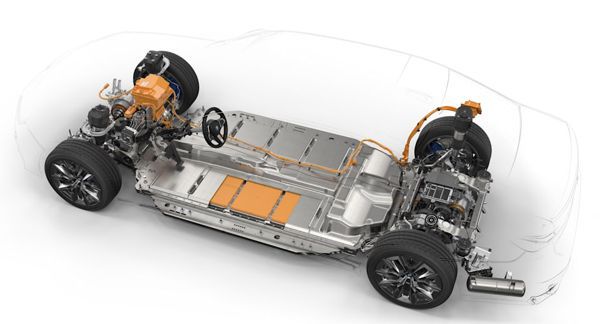 |
|
Underfloor
battery is the cause of its elevated height.
|
|
At the mean time,
the only i7 model is xDrive60. Its 258 hp front motor and 313 hp rear
motor offer a combined output of 544 hp and 549 lbft, propelling the
2640 kg heavyweight to 60 mph in 4.5 seconds and ultimately reaches
only 149 mph. As demonstrated by i4, BMW's CLAR platform is so flexible
that it can accommodate the i7's 102 kWh worth of floor-mounted battery
and an electric motor for each axle, all the while allowing the
conventionally powered 7-Series to be built on the same production line
at Dingolfing plant, which is quite brilliant. On the downside, that
means the packaging efficiency of the 7-Series has to compromise, which
explains the added size, tallness and massive weight gain.
The i7 xDrive60 has a WLTP range of 367-388 miles (590-625 km) or EPA
range of 296-318 miles depending on wheels and options. Its quick
charging rate of 195 kW is not quite as quick as the likes of Porsche,
Hyundai or Tesla, but competitive with Mercedes EQS.
Obviously, the i7 is not quite as aerodynamic efficient as Mercedes
EQS, but its Cd of 0.24 is still pretty good. Its 7-Series siblings
need more cooling to engine, so drag coefficient is lifted to 0.26.
As most development budget has been spent to electrified powertrains
and interior technology, the G70 sees little progress in its chassis
development. In fact, it might have taken a step backward. While the
old car introduced some carbon-fiber structural elements to cut weight,
the new car reverted to the more conventional hybrid structure of
aluminum and steel. BMW did not mention any improvement in chassis
rigidity. Improvement to NVH comes mainly from the addition of a shear
panel under the front structure, the use of hydro mounts at rear
subframe and elastic steering gear mounting.
Suspension continues to rely on double-wishbones up front and 5-link
axles at the rear, supported with air springs and adaptive dampers.
Active anti-roll system is now implemented by 48V motors. The optional
rear-wheel steering turns up to 3.5 degrees in opposite direction, so
not quite as nimble in town as Mercedes.
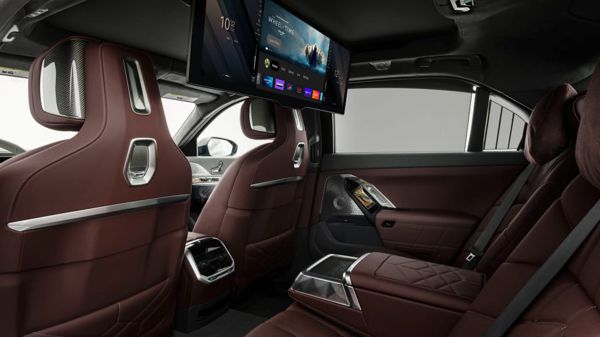 |
|
31-inch
infotainment screen offered at the rear. Just don't watch "Gone of the
Wind".
|
|
The 7-Series’ cabin is spacious for
both rows. Its boxy body gives rear passengers plenty of headroom,
unlike Mercedes EQS. Predictably, for a car targeting strongly at China
where the boss normally sits at the back, the airliner rear seat has
all the luxury features expected: heated, vented, massaged and
reclining. When it reclines, the front passenger seat slides forward
and folds away, and a leg rest extends from the rear seat. A 31-inch
screen pulls down from the panoramic roof. Use the 5-inch touchscreen
incorporated at the door’s grab handle, you can activate the all-round
window shades, turning the rear cabin into a theatre, enjoy your
favourite movies or operas. The Bowers & Wilkins audio system
produces fabulous sound. Mind you, don’t watch “Gone of the Wind”
there, because you will definitely get neck strain after 4 hours. As
large as the 7-Series’ cabin is, the movie screen is still too close
and too high for a natural watching position. Also, it is positioned in
the middle of the roof rather than right in front of you.
The cabin of i7 is basically the same as its 7-Series siblings, but its
thicker battery elevates the cabin floor a little, reducing rear leg
and foot room a little bit.
Up front, the cabin design lacks the opulence of Mercedes S-class or
Bentley Flying Spur. Materials are high-quality, of course, but they
don’t feel as exquisite as its best rivals’. Instead, BMW’s interior
design emulates a modern living room, emphasizing a spacious and
inviting environment. The curved display panel consists of a 12.3-inch
instrument display and a 14.9-inch touchscreen whose graphics are
excellent and response quick, but that simple panel has no styling or
character to speak of, so Chinese car makers can easily copy. The
i-Drive controller at the transmission tunnel is more convenient to use
on the move than pure touchscreen, but most other switches have been
ditched and taken over by the touchscreen (or voice command, or gesture
control), which is less intuitive. Perhaps feeling not classy enough,
BMW’s interior designers added a crystalline bar, spanning across the
entire dashboard and extending into the doors. It incorporates ambient
lighting and touch controls for the seats and climate control system.
It looks cool at night when glows blue, but could reflect under
sunlight and catch fingerprints easily.
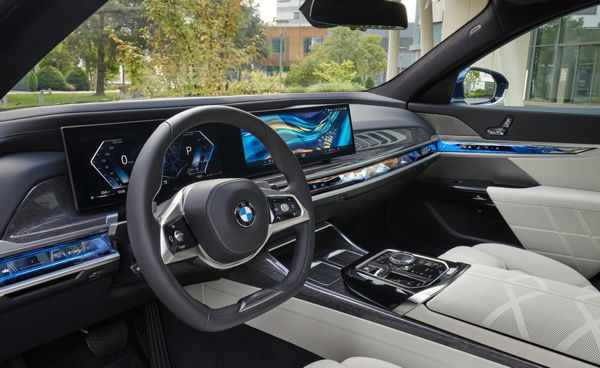 |
|
Overall,
the i7 and 7-Series are more convincing than Mercedes EQS, but an
S-class is still a shade better, and far prettier.
|
|
Despite its taller
and bulkier looks, on the road the 7-Series retains the traditional
driving dynamics of BMW. In the context of a large luxury limousine, it
is keen to steer and maneuver. In Sport mode, the air suspension and
(if so equipped) active anti-roll bars keep body control tight in the
twisty, and the rear-wheel steering makes it feel smaller than it is.
The grip and traction afforded by xDrive, the light yet responsive
steering and strong brakes give it a stronger driver appeal than other
large luxury limousines except Bentley Flying Spur – which rides on
Porsche platform, remember. Ultimately, you can’t fool the laws of
physics if keep pushing hard to its limits, but I doubt how many
drivers (or chauffeurs?) would push it so hard. Meanwhile, the 7-Series
rides better than any of its predecessors. It is cosseting and calm.
Large and small bumps are well absorbed, except high-frequency small
irregularities like washboard pavement, which is a common weakness of
air suspensions. Highway cruising is quiet and relaxing. It feels
travelling slower than it is. An S-class still rides more smoothly, but
the new 7er is not far behind.
The engine range is so vast that only V8 has been tested so far.
Predictably, it is powerful, responsive yet smooth and refined. The
addition of mild hybrid motor fills the torque gap during gearshifts,
making the progress smoother than ever.
However, the i7 xDrive60 is more impressive. In spite of inferior
performance claims, it feels slightly stronger in the real world,
thanks to the immediately available peak torque. The quiet and seamless
manner of electric power suits the luxury limousine very much, although
keen drivers would prefer the V8’s exhaust note over the spaceship
soundtrack composed by Hans Zimmer. It feels just as refined as a
Rolls-Royce. The i7 also hides its substantial weight better than its
V8 sibling, thanks to the lower center of gravity and better front to
rear balance (49:51 vs 55:45). It corners admirably flat. BMW also
blends the regenerative braking and mechanical braking seamlessly. Push
harder though, you will find the 760i pulls stronger at higher speeds
and corners a bit harder, while its steering delivers a shade more
feel, all down to its 370 kg lighter weight. However, compared to
Mercedes EQS, the i7 is definitely a better driver’s car. It doesn’t
match the Mercedes in driving range, but its interior space and build
quality are more convincing. Strangely, BMW’s transitional CLAR
platform beats Mercedes’ dedicated EVA platform.
Starting from £108K, the i7 is also significantly cheaper than
the £138K EQS580, no wonder Mercedes needs to slash its price
massively in China recently. However, don’t forget the conventional
S-class is still the most convincing luxury car in the F-segment. The
7-Series and i7 are slightly less comfortable in ride and less
luxurious inside, while the S-class trumps them easily on aesthetic. If
you look for cheaper alternative, a Genesis G90 would not be a bad
choice. If you want something more furistic and faster, Lucid Air won’t
disappoint.
|
Verdict:     |
|
|
|
|
|
|
|
|
|
|
740i
|
2022
|
Front-engined,
RWD
|
| Aluminum + steel monocoque |
Steel + aluminum
|
| 5391 / 1950 / 1544 mm |
| 3215 mm |
Inline-6, Miller-cyle, mild-hybrid motor
|
| 2998 cc |
DOHC 24 valves, DVVT, VVL
|
Turbo
|
| DI |
380 hp
|
383 + 147 = 398 lbft
|
| 8-speed automatic |
F: double-wishbone; R: multi-link
|
Adaptive air spring + damping
|
F: 255/45YR20; R: 285/40YR20
|
2090 kg
|
| 155 mph (limited) |
5.2 (c)
|
| - |
|
740d
xDrive
|
2022
|
Front-engined,
4WD
|
| Aluminum + steel monocoque |
Steel + aluminum
|
| 5391 / 1950 / 1544 mm |
| 3215 mm |
Inline-6, diesel, mild-hybrid motor
|
| 2993 cc |
DOHC 24 valves
|
VTG turbo
|
| CDI |
286 + 18 = 299 hp
|
479 + 147 = 494 lbft
|
| 8-speed automatic |
F: double-wishbone; R: multi-link
|
Adaptive air spring + damping
|
245/50YR19
|
2180 kg
|
| 155 mph (limited) |
5.5 (c)
|
| - |
|
750e
xDrive
|
2022
|
Front-engined,
4WD, 4WS
|
| Aluminum + steel monocoque |
Steel + aluminum
|
| 5391 / 1950 / 1544 mm |
| 3215 mm |
Inline-6, Miller-cyle, electric motor
|
2998 cc, 18.7 kWh battery
|
DOHC 24 valves, DVVT, VVL
|
Turbo
|
| DI |
313 + 197 = 489 hp
|
332 + 206 = 516 lbft
|
| 8-speed automatic |
F: double-wishbone; R: multi-link
|
Adaptive air spring + damping
|
245/50YR19
|
2380 kg
|
| 155 mph (limited) |
4.7 (c)
|
| - |
|
|
|
|
|
Performance
tested by: *C&D
|
|
|
|
|
|
|
M760e
xDrive
|
2022
|
Front-engined,
4WD, 4WS
|
| Aluminum + steel monocoque |
Steel + aluminum
|
| 5391 / 1950 / 1544 mm |
| 3215 mm |
Inline-6, Miller-cyle, electric motor
|
2998 cc, 18.7 kWh battery
|
DOHC 24 valves, DVVT, VVL
|
Turbo
|
| DI |
381 + 197 = 571 hp
|
383 + 206 = 590 lbft
|
| 8-speed automatic |
F: double-wishbone; R: multi-link
|
Adaptive air spring + damping,
active anti-roll bar
|
255/40YR21
|
2450 kg
|
| 155 mph (limited) |
4.1 (c)
|
| - |
|
760i
xDrive
|
2022
|
Front-engined,
4WD, 4WS
|
| Aluminum + steel monocoque |
Steel + aluminum
|
| 5391 / 1950 / 1544 mm |
| 3215 mm |
V8, 90-degree, mild hybrid motor
|
| 4395 cc |
DOHC 32 valves, DVVT, VVL
|
Twin-turbo
|
| DI |
544 hp
|
553 lbft
|
| 8-speed automatic |
F: double-wishbone; R: multi-link
|
Adaptive air spring + damping,
active anti-roll bar
|
F: 255/45YR20; R: 285/40YR20
|
2270 kg
|
| 155 mph (limited) |
4.1 (c) / 3.5*
|
| 8.6* |
|
|
|
|
|
|
Performance
tested by: *C&D
|
|
|
|
|
|
|
i7
xDrive60
|
2022
|
Front &
rear motors, e-4WD, 4WS
|
| Aluminum + steel monocoque |
Steel + aluminum
|
| 5391 / 1950 / 1544 mm |
| 3215 mm |
Electric motor x 2
|
102 kWh (net) battery
|
-
|
-
|
-
|
544 hp
|
549 lbft
|
1-speed
|
F: double-wishbone; R: multi-link
|
Adaptive air spring + damping
|
F: 255/45YR20; R: 285/40YR20
|
2640 kg
|
| 149 mph (limited) |
4.5 (c) / 4.5* / 4.1**
|
10.1* / 9.6**
|
|
i7
M70 xDrive
|
2023
|
Front &
rear motors, e-4WD, 4WS
|
| Aluminum + steel monocoque |
Steel + aluminum
|
| 5391 / 1950 / 1544 mm |
| 3215 mm |
Electric motor x 2
|
102 kWh (net) battery
|
-
|
-
|
-
|
659 hp
|
811 lbft
|
1-speed
|
F: double-wishbone; R: multi-link
|
Adaptive air spring + damping,
active anti-roll bar |
F: 255/40YR21; R: 285/35YR21
|
2695 kg
|
| 155 mph (limited) |
| 3.6 (c) |
-
|
|
|
|
|
|
|
Performance
tested by: *Autocar, **C&D
|
|
|
|
|
|
|